
It’s
Over: UC Wins Lab Contract on Merit
The UC Management Contract:
What’s New?
It’s Over: UC Wins Lab Contract on Merit
While it came as no great surprise, the awarding of Berkeley Lab’s management contract to the University of California by the Department of Energy last week came as a relief to Laboratory employees who couldn’t imagine a world without UC’s parentage.
The welcome news found Lab Director Steve Chu in South Korea, UC President Robert Dynes in Sacramento, and Deputy Director Graham Fleming in Washington. But they connected with Associate Laboratory Director David McGraw for a media conference call on April 19, and nearly 800 Lab staff connected to the announcement via web streaming video.
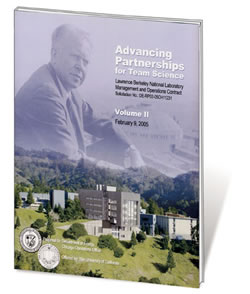
What they heard was this: they were still UC employees, and would be for at least another five years. Under criteria that reward outstanding performance, the University’s contract could be extended for up to 20 years without further competition.
And for those who feared outside influence intruding on the research, not to mention jeopardizing their UC benefit and pension programs, the news was indeed sweet.
“I’m very pleased about all of this,” Dynes said from his car phone. “I congratulate Steve Chu and all of his employees. With Steve’s leadership, they have put together a vision that I’m very excited by. I’ve followed this [process] very closely from the beginning, and I’m delighted for the administration.”
In a prepared statement, he added, “Lawrence Berkeley Laboratory is an excellent example of the successful interaction between universities and the federal government in managing a scientific research facility and producing results of national significance. Lawrence Berkeley Laboratory is about breathing life into ideas and bringing researchers together in a rich interdisciplinary environment to solve the scientific and technological challenges facing our nation and world.”
Energy Secretary Samuel Bodman was no less effusive. “Because of its outstanding work, including 10 Nobel Prizes won by its scientists, [Berkeley Lab] has helped ensure U.S. scientific leadership for more than 60 years. This contract award will allow LBNL and its outstanding researchers and staff to seamlessly continue their work as they set new standards of scientific excellence.”
Thus concluded an intensive months-long preparation by UC and the Lab for a competition that may or may not have had another competitor (the DOE isn’t saying). But that doesn’t matter. As Chu told the reporters on the phone call, the DOE made it clear from the start that it would only award a contract if the proposal was acceptable. More than that, it was exceptional, according to several comments written in its final report by the DOE’s Selection Evaluation Board (SEB).
At the forefront of it all was Chu, who was described by the SEB as an “outstanding choice” for director, with “impeccable science credentials.” Of the leadership team, the board cited its “excellent ability to work well together” with a “strong group of key personnel on the operations side.” Fleming was characterized as someone with “strength and depth, both as a manager and as a scientist.”
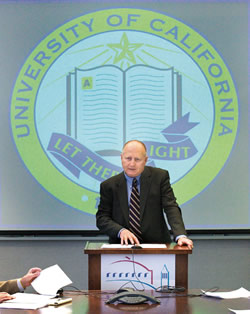 Associate Laboratory Director David McGraw addressed the media conference on April 19, with Lab Director Steve Chu and Deputy Director Graham Fleming participating via a long-distance conference call.
Associate Laboratory Director David McGraw addressed the media conference on April 19, with Lab Director Steve Chu and Deputy Director Graham Fleming participating via a long-distance conference call.
The University of California received accolades for its legacy of management success, borne out by the Laboratory’s track record for world-class science. UC has been at the helm since the federal government began supporting Berkeley Lab in 1943, and before that when the old “Rad Lab” was a part of the UC Berkeley campus. Contiguous in geography and partners in sharing resources and personnel, Berkeley Lab and the campus are inextricably connected, and Chu foresees even greater partnerships in the future.
“We want to broaden those relationships,” he said. “And we can strengthen our collaboration with all 10 campuses. We will expand our biomedical work with UCSF (San Francisco), and we can build dual-use buildings with UC Berkeley.” The latter plans he described as “very preliminary,” subject to approval by the UC Regents. But if he succeeds, Chu will see computing sciences support and materials and nanotechnology buildings erected in the next several years near the perimeters of the two institutions, bridged by their cooperative uses.
The euphoria about the continuing UC-Lab relationship extended to the politicians, too. California Senator Dianne Feinstein, in applauding the award, called Berkeley Lab “a wonderful scientific and technological resource for the Bay Area, Califor-nia and the nation. With 10 Nobel Prize winners, 12 National Medal of Science winners, and more than 250 joint appointments with the Univer-sity of California system, I am confident that Berkeley Lab will continue to be on the cutting edge of science and technology.”
No less impressed was Congress-woman Barbara Lee (D-Oakland), the Lab’s representative in the House of Representatives. In a brief statement, she congratulated UC on winning the competition and called Berkeley Lab “an integral part of the economic and scientific well-being of California and the nation.”
And California Governor Arnold Schwartzenegger called the decision “a great victory” for the people of California and for UC, noting that it “reaffirms that our public university system is the envy of the nation and will help continue to bring the most talented and insightful scientists to the Golden State.” He pledged to work on keeping the Livermore and Los Alamos labs under UC care, too. Neither has begun competition yet.
Following a short transition period, the initial contract term will begin on June 1. Transition activities will be largely transparent to most Laboratory employees, mostly involving transfer of regulatory and compliance commitments from the old contract to the new.
The UC Management Contract: What’s New?
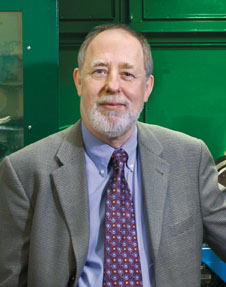 Laboratory Deputy Director Graham Fleming
Laboratory Deputy Director Graham Fleming
Fresh from their proud moment announcing University of California’s continuing management partnership with Berkeley Lab and the DOE, Laboratory Deputy Director Graham Fleming and Associate Laboratory Director for Operations David McGraw sat down with the View and discussed Lab life under the new contract. Not surprisingly, they characterize it as same as the old life, but better.
Begin with the clause that leaves open the possibility of extending the UC affiliation for 20 years, not just an initial five. The prospect of not going through the time and expense of competition again is indeed incentive to fulfill the contract’s highest performance measures that would qualify the Lab for automatic extension.
And what about University pensions and benefits, a source of anxiety for many long-time Laboratory employees? No change at all, says McGraw. “We’re all still UC employees,” he said, “and future employees will be, too. Nothing is different (in this contract).”
One thing that does change is the level of assessment and evaluation of performance that’s built into the management process. A new Institutional Assurance Office at the Lab, reporting to Fleming, combines several functions — project management, the “balanced scorecard” approach to measuring effectiveness, internal control assessments, and integration of “best practices.” Jim Krupnick, the Lab’s project management head, will lead the new assurance effort.
At the UC Office of the President, a new governance structure will be put into place to oversee the work at Berkeley Lab and provide high-level advice to managers in both operations and science. The 12-person board will include high-profile leaders in business and academia and will be co-chaired by M.R.C. Greenwood, the University’s provost and senior vice president for Academic Affairs. “Expect an active, not just symbolic board,” McGraw predicted.
Over the next 40 days, Joseph Rasson and Jim Krupnick will oversee a transition period leading to the close-out of “Contract 98” and the implementation of the new agreement. In particular, changes in rules and standards need to be incorporated into the new contract’s expectations.
The key scientific goals and directions outlined in the contract proposal offer a roadmap for the science strategy to be pursued under the new agreement. Among them are:
- New energy technologies and environmental solutions, including development of chemical fuels from solar energy and safe, effective carbon sequestration systems.
- Discovering the nature of matter and energy in the universe, and featuring the continued development of a detector and satellite for “dark energy” exploration.
- Living systems engineered through quantitative biology, to enable the production of synthetic fuels, environmental and health protections, etc.
- Designer materials through nanoscience, leading to advanced fuels, motors and electricity-generating systems.
- Advanced x-ray and ultrafast science, to further explore energy and materials processes, biological systems, and the environment.
- Advanced computing, with new capabilities and architectures to enable the next level of scientific discovery.
Fleming also noted the contract’s emphasis on employee development and its intent to hire a considerably expanded number of divisional fellows to move the brightest and most promising scientific talent up the career ladder on a fast track. Another program, called Seaborg Fellowships, will attract very-early-career scientists from an international pool with an emphasis on interdisciplinary research. UC will appoint 20 postdoctoral fellows over the next two years.
The contract proposal also addressed how the Lab conducts searches for scientific appointments and stressed a new effort to include multiple-discipline representation in divisional search committees to foster more interdisciplinary science — perhaps the most pervasive element in the entire document.
Divisions and programs are to develop “living lists,” which are lists of prospective candidates from underrepresented or historically disadvantaged groups that can be tracked and kept up to date for future recruitments.
“We want to know where they are, and who their mentors are,” Fleming said. “Then we can go to their mentors to more effectively find out who can help us.”
On the Operations side, McGraw said the contract commits to replacing many Department of Energy orders with compliance goals matched against national standards. Services will be largely provided and managed under a “best practices” approach growing from a comparison study Berkeley Lab, the Jet Propulsion Laboratory, and the National Center for Atmospheric Research produced last year.
The Heroes Behind the Success
The University of California and Berkeley Lab institutionally received the praise. But there are 47 employees who quietly toiled in a suite of cubicles at Oakland’s Office of the President for more than four months who should accept the applause. It was called the Acquisition Team and, under Bill Barletta’s management, it produced a four-star contract proposal that, by all indications, overwhelmed the DOE’s selection board.
“The University owes a great debt of gratitude to the members of the Acquisition Team,” said Barletta, who temporarily left his position as division director for Accelerator and Fusion Research to head the contract effort for the Lab. “Without their dedication, hard work, and forbearance, we could not have submitted a quality proposal. Likewise, I wish to thank my deputy, Joseph Rasson, and my acquisition coordinator, Linda Matyas, for their constant support; it was invaluable to me.”
Below, in alphabetical order, are the contributors — writers, editors, graphic designers, and management overseers — who helped put together the winning proposal.
From Berkeley Lab:
- Chuck Axthelm
- Jane Baynes
- David Busby
- Michael Chartock
- David Chen
- Joe Chew
- Cynthia Coolahan
- Jeffrey Fernandez
- Cheryl Fragiadakis
- Carla Garbis
- Don Grether
- Sherrie Harding
- Rob Johnson
- Karin Levy
- Brenda Lew
- Douglas Lockhart
- Stuart Loken
- Linda Matyas
- David McGraw
- Sandy Merola
- Michelle Mock
- Karl Olson
- Pam Patterson
- Phyllis Pei
- Paul Preuss
- Joseph Rasson
- George Reyes
- Art Robinson
- Kem Robinson
- Mark Rosenberg
- Ed Sayson
- Randy Scott
- James Siegrist
- R. P. Singh
- Nancy Slater
- Nancy Talcott
- Nancy Ware
- Robin Wendt
- Jeff Wiener
- Otis Wong
- Glenn Woods
- Gary Zeman
From Lawrence Livermore:
- Alex Ballard
- Galen Hazelhofer
- Denise Kellom
- Kitty Madison
Keasling to Head Physical Biosciences
Jay Keasling, a chemical engineer by training who has risen to prominence in the burgeoning field of synthetic biology, has been named by Lab Director Steve Chu as the new director of the Physical Biosciences Division (PBD). He succeeds Graham Fleming, who recently became Berkeley Lab’s deputy director.
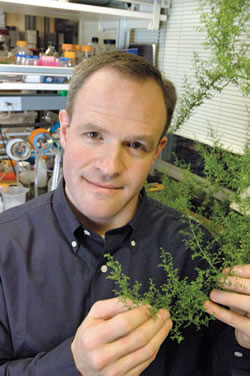 Jay Keasling
Jay Keasling
“I’m excited about the opportunity to lead the division,” said Keasling. “I look forward to working with the excellent scientists in PBD to build research collaborations within the division and with other divisions at Berkeley Lab to tackle some of the grand challenges facing our society, particularly those in the area of renewable energy, all the while doing the first-class science for which PBD is famous.”
In his acceptance statement, Keasling also noted that he has “very large shoes to fill.” PBD was founded in 1997 by Fleming, who served as its director until now. Under his leadership, PBD grew from a staff of less than 100 and an annual budget of $7.2 million, to its current staff of some 400 people and a FY 2005 budget of $32 million. Among Fleming’s accomplishments was the creation in 2003 of the Synthetic Biology Department, the world’s first such department in a major scientific research institute. He named Keasling to head that department.
Keasling, who joined PBD in 2002, holds an appointment with UC Berkeley as a professor of chemical engineering. He joined the campus in 1992 after earning a post doctorate in biochemistry from Stanford. He received his undergraduate degree in chemistry and biology from the University of Nebraska in 1986 and his Ph.D. in chemical engineering from the University of Michigan in 1991.
Keasling’s research has focused on the genetic engineering of microbes to cheaply synthesize and mass produce therapeutic drugs desperately needed in third-world nations. During the past two years he has achieved spectacular results. In one study, he developed a strain of E.coli that can produce artemis-inin, an antimalaria super drug that is far too costly right now for countries in Africa and South America, where malaria kills more than a million children each year. This past year, the Bill and Melinda Gates Foundation awarded a $42.6 million grant to take Keasling’s development to the commercial production level. In another study, he’s been developing a similar strain of E.coli for the synthesis of pro-stratin, a chemical compound that holds great therapeutic potential as an anti-AIDS drug. A landmark agreement has been signed between UC Berkeley and the Samoan government to isolate the gene for prostratin, which is contained in the mamala tree of Samoa.
“Science is evolving, and the methods we now use and the questions we ask are more interdisciplinary than ever,” Keasling said at his first PBD review as division director. “At PBD we’re going to continue to integrate the techniques and concepts of the physical and engineering sciences to strengthen our investigation of living things.”
Heart of ATLAS Getting Ready for Cern
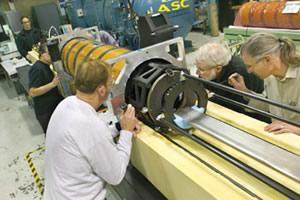
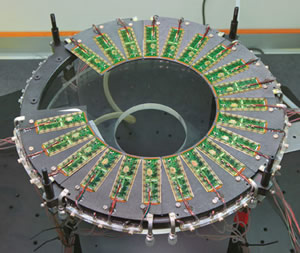
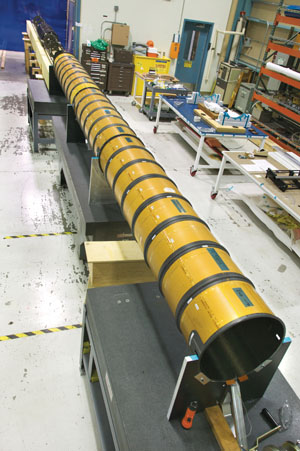
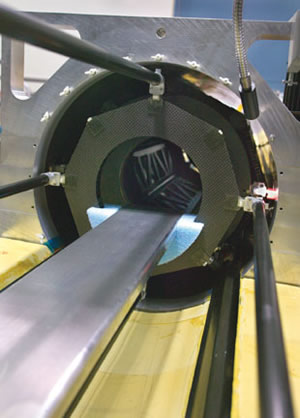
The innermost heart of the ATLAS detector for CERN’s Large Hadron
Collider is taking shape in Building 77A, where members of the Engineering
and Physics divisions are assembling the support structure for ATLAS’s
pixel detector. The pixel detector surrounds a point within the Large
Hadron Collider’s beam pipe where energetic beams of protons
collide with each other and is designed to register upwards of 40
million particle hits per square centimeter per second.
Clockwise: (1) Tom Weber, Mario Cepeda, Tom Johnson, John Worth, Gil
Gilchriese, and Rod Post check the placement of the pixel detector
within its central support tube. (2) One of the three disks comprising
each end cap show seven of the eight “pizza slices” of
pixel modules. (3) The complete package to be shipped to CERN includes
beam-pipe and service support modules. The full-length support tube,
almost 7.5 meters long, incorporates copper-foil elements for temperature
control and shielding against electromagnetic interference. (4) The
pixel detector support frame is constructed of low mass, extremely
stiff, highly radiation-resistant carbon fiber and epoxy compounds
— gram for gram 10 times as stiff as metal. Each disk mounts
a total of 48 pixel modules, 24 on each side. Photos by Roy Kaltschmidt,
CSO
Environmental Fair: Segways, Hybrids, Plants, Oh My!
On April 21 the cafeteria parking lot was teeming with helmeted employees happily zooming around on the latest transportation fad — two-wheeled Segways provided for test drives by Segway of Oakland. The environmentally-friendly, battery-powered machines were but one of the many attractions at the annual Environmental Fair, held last Thursday in observance of Earth Month.
Employees and vendors staffed information tables promoting everything from vegetation management to employee organizations such as the Green Team, the Outdoor Club, and the Lab’s Bicycle Coalition. Outside vendors included Friends of Strawberry Creek, Rebuilding Together, and Boise Cascade, whose representative gave away small potted plants — an annual tradition at the fair.
A Toyota dealer was also onsite, drawing a crowd for its PRIUS hybrid car, on display in the parking lot outside the cafeteria.
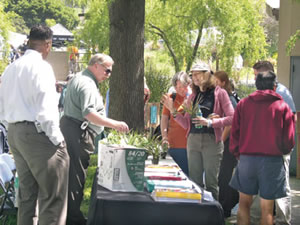
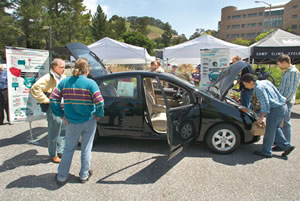
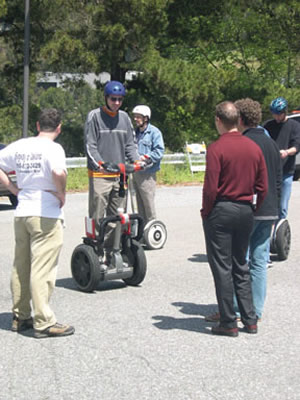
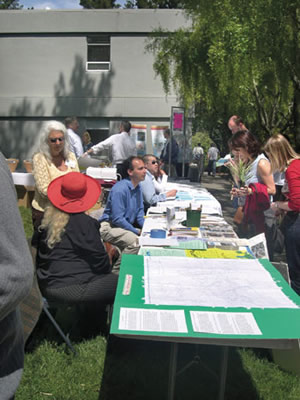
Building a V6 for the Nano-Age
The world of the very small is about to receive a very powerful engine. Berkeley Lab scientists have created the world’s smallest electric motor, which may someday power nanoscale devices that walk, crawl, swim, and fly.
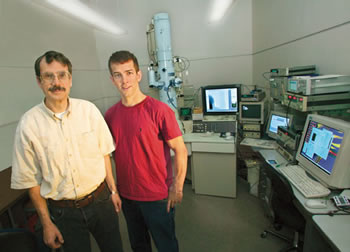 Alex Zettl and Chris Regan led the team that developed the nanomotor.
Alex Zettl and Chris Regan led the team that developed the nanomotor.
Although it is too early to determine what the motor will propel — perhaps probes that deliver disease-fighting drugs inside the body or winged nanobots that sniff out explosives — it packs a big kick in its tiny frame. The motor measures only 200 nanometers long (a nanometer is one-billionth of a meter), but its power density is 100 million times greater than that of a 225-horsepower V6 engine. It draws its enormous power from surface tension, the same cohesive force between liquid molecules that allows bubbles to form and insects to walk on water.
“Surface tension becomes more important as objects become smaller, and at the nanoscale, it dominates,” says Chris Regan of the Materials Sciences Division (MSD), who developed the motor with fellow MSD researchers Shaul Aloni, Kenneth Jensen, and team leader Alex Zettl. Aloni, Regan and Zettl are also scientists with UC Berkeley’s physics department, where much of the work was conducted.
Their device is based on carbon nanotubes, which are hollow cylinders of pure carbon about 10,000 times smaller than the diameter of a human hair. Last year, the Berkeley Lab scientists developed a way to move indium particles along the tube like auto parts on an assembly line. Their nanoscale “conveyor belt” can be aimed anywhere scientists want to deliver mass atom-by-atom, the makings of a formidable nanoassembly tool.
Now, the same team has converted the conveyor belt into a tiny motor with Herculean strength. To build the engine, two molten indium droplets, one big and one small, are positioned side by side on a carbon nanotube. Next, an electric current is sent through the nanotube, which causes individual indium atoms to shuttle from the large droplet to the small droplet. The small droplet grows until it touches the large droplet — and then surface tension takes over. In less than a nanosecond, all of the small droplet’s atoms are transferred to the large droplet, and the small droplet collapses to nothing.
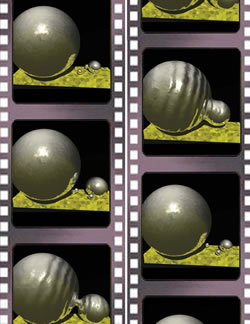 These computer-generated stills illustrate the world’s smallest
motor in action. The large droplet donates atoms to the smaller droplet,
which then grows, touches the larger one, and implodes. (Image courtesy
Zettl Research Group)
These computer-generated stills illustrate the world’s smallest
motor in action. The large droplet donates atoms to the smaller droplet,
which then grows, touches the larger one, and implodes. (Image courtesy
Zettl Research Group)
“It is like an energetic catastrophe when the two beads meet,” says Reagan. “We pump a lot of energy into the system, and then it is released very quickly.”
After the collapse, the cycle begins anew. The large droplet once again donates atoms to its smaller neighbor. And once again, as soon as the two droplets make contact, the small droplet relinquishes its atoms and implodes.
This repetitive build-up followed by a sudden collapse mimics the same two-speed, back-and-forth motion that many animals use to run, swim, and fly. For example, a fly doesn’t fly like an airplane. It flies because its wings move faster in one direction than the other direction, which creates a vortex that produces lift. And a swimmer moves through the water because the stroke that pushes her forward is more powerful than her recovery stroke. Likewise, if the motor’s slow-fast motion can be transferred to nano-sized legs, flippers, and wings, then nanoscale devices could be as quick and nimble as a housefly or a brook trout.
“Our motor is also ideal for locomotive applications because it is very strong for its size,” says Regan.
Its strength comes from the fact that the motor’s power stroke, which occurs when the small droplet collapses, is driven by surface tension. This force becomes more important as objects become smaller, which is why insects can manipulate surface tension as easily as a person dribbling a basketball. Some insects can drag air bubbles underwater to help them breathe, much like a person holding 10 gallons of water in his bare hands.
In other words, surface tension is one million times more important
for millimeter-scale insects than it is for meter-scale humans. It
is even more important at the micron scale, which is why scientists
harness it to assemble microelectromechanical devices that measure
one-millionth of a meter. And at the nanoscale, surface tension reigns
supreme. The Berkeley Lab team’s motor dissipates 20 microwatts
of power when surface tension forces the smaller droplet to collapse.
This represents a power density that dwarfs that of human-scale engines.
 Attach nano-sized legs or wings to this engine, and tomorrow’s
nanobots could be as fast and nimble as a housefly. (Image courtesy
Zettl Research Group)
Attach nano-sized legs or wings to this engine, and tomorrow’s
nanobots could be as fast and nimble as a housefly. (Image courtesy
Zettl Research Group)
In addition, the motor’s speed can be manipulated by changing the voltage of the DC current that sends indium atoms scurrying from one droplet to the other. The lower the voltage, the slower this transfer occurs and the slower the droplets’ oscillations. Higher voltages could increase the motor’s frequency into the megahertz range, meaning the droplets oscillate more than one million times per second. Gener-ating such frequencies with DC electrical power means the motor can be powered by a battery or solar cell without additional high-frequency circuitry, making it ideal for mobile applications.
The motor is also the first oscillator with a relaxation phase driven by surface tension. Relaxation oscillators are systems characterized by two time scales: a slow build up of tension followed by a rapid release. A dripping faucet is one such relaxation oscillator. In its case, surface tension is important during the build-up phase of the water droplet. It restrains the slowly growing droplet until the tension suddenly gives way to gravity. In the nanoscale motor, however, electricity drives the build-up of energy, and surface tension drives its rapid release.
“It’s fast, simple, and very powerful,” says Regan. “It also represents a world record in terms of synthetic mechanical intricacy. We have two moving parts within a box that is 200 nanometers on its side. No man-made machine is this small.”
The group’s paper, “Surface-tension driven nanoelectromechanical relaxation oscillator,” appeared in the March 18 online edition of Applied Physics Letters.
JGI Refines Environmental Fingerprinting
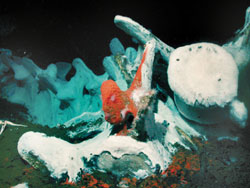 DNA material was obtained from whalebones one mile under water. This
photo was taken four-and-a-half years after the whale sank in 1998.
DNA material was obtained from whalebones one mile under water. This
photo was taken four-and-a-half years after the whale sank in 1998.
Thriving in every conceivable environmental niche, the vast majority of microbes are resistant to being grown under standard laboratory conditions. This makes it difficult for scientists to study the little critters and find out how their specialized metabolic properties can either maintain the delicate environmental balance or wreak havoc.
Enter the sleuthing scientists from the Joint Genome Institute (JGI), who cut to the chase with a new strategy for comparing diagnostic DNA signatures — telltale signs of particular environments — in a study published in the April 22 issue of the journal Science.
In the study, information-rich snippets of DNA sequence were teased out of genetic material from diverse terrestrial and aquatic habitats, including Minnesota farm soil and whalebones from a mile underwater. Then, by comparing these unassembled pieces of complex environmental jigsaw puzzles, site-specific motifs came to light — ones that can be used to detect environments under stress as well as signal progress in remediating contaminated environments.
“These DNA sequence fingerprints can be used to provide highly accurate assessments of the vitality of extremely diverse environments,” said Ray Orbach, head of the Depart-ment of Energy’s Office of Science, which supported the research. “These fingerprints can be used to reveal environments under stress, as well as signal progress in remediating contaminated environments. This may well develop environmental ecology into a fully quantitative science.”
Dubbed Environmental Genomic Tags, or EGTs, these indicators capture a DNA profile of a particular niche and reflect the presence and levels of light, nutrients, pollutants, and other features. This metagenomics approach holds promise for accelerating advances in environmental sciences akin to the contributions DNA sequencing has already made to biomedical sciences.
In the early 1990s, incomplete fragments of human genes called Expressed Sequence Tags (ESTs) were used to distinguish unique features of human tissues, allowing researchers to home in on important disease genes long before the completion of the entire human genome.
“EGT fingerprints may be able to offer fundamental insights into the factors impacting on various environments,” said JGI Director Eddy Rubin, who led the research team. “With EGTs we don’t actually need a complete genome’s worth of data to understand the functions required of the organisms living in a particular setting. Rather, the genes present and their abundances in the EGT data reflect the demands of the setting and, accordingly, can tell us about what’s happening in an environment without knowing the identities of the microbes living there.”
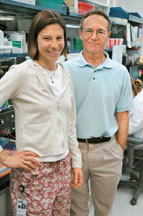 Lab postdoc Susannah Green Tringe, first author of the Science paper
on “Comparative Metagenomics of Microbial Communities”
with JGI Director Eddy Rubin, who led the research team.
Lab postdoc Susannah Green Tringe, first author of the Science paper
on “Comparative Metagenomics of Microbial Communities”
with JGI Director Eddy Rubin, who led the research team.
For example, genes involved in breaking down plant material are overrepresented in soil and absent in sea water, while in sea water, genes involved in the passage of sodium, a major chemical component of salt water, were particularly abundant. As light is a major energy source for microbes living in surface water, there was an abundance of genes involved in photosynthesis in samples collected from shallow water. These differences in the abundances of genes involved in particular functions provide DNA clues to features of the environments from where the samples were taken. Importantly, the DNA clues were easy to find despite the vast numbers of different individual microbial species within the samples.
Rubin argues that the genes and their relative abundance, as gleaned from EGTs, reflect the intricate physical and biochemical details of a given environment without having to know the actual identities of the resident microbes. This finding is crucial for studies of microbes in the wild since the sheer number of different organisms present in nearly all environments makes it a daunting task to sequence the multitude of organisms one at a time. With the EGT approach, an abbreviated sequencing effort enables scientists to piece together the information and form a useful metabolic picture of an entire complex environment.
Rubin lab postdoctoral fellow Susannah Green Tringe was first author on the Science paper, which also included JGI researchers Art Kobayashi, Asaf Salamov, Chris Detter, and Phil Hugenholtz, as well as collaborators from Diversa Corporation and the European Molecular Biology Laboratory in Heidelberg, Germany.
Supported primarily by the Department of Energy, the Joint Genome Institute is among the world leaders in whole-genome sequencing projects devoted to microbes and microbial communities, model system vertebrates, aquatic organisms, and plants. Established in 1997, JGI is a multi-institutional collaboration which includes Berkeley Lab. For more information see http://www.jgi.doe.gov/.
A Different Spin on Future Data Storage
The next generation of computers will be “instant-on,” meaning they won’t need to be booted up to move hard drive data into memory. They will also store data in a smaller space and access it faster while consuming less power than today’s machines, thanks in part to the development of magnetic random access memory chips, or MRAM.
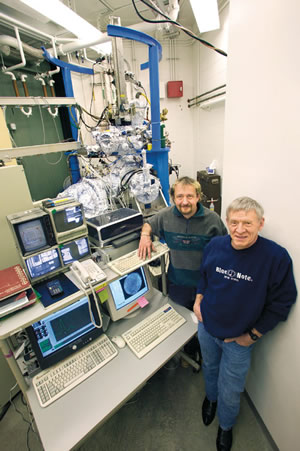 Norman Mannella (left) and Charles Fadley at ALS Beamline 4.0.2, where
they used multiple spectroscopy techniques to detect the temperature-dependent
formation of Jahn-Teller polarons in manganites, which are linked
to colossal magnetoresistance, or CMR.
Norman Mannella (left) and Charles Fadley at ALS Beamline 4.0.2, where
they used multiple spectroscopy techniques to detect the temperature-dependent
formation of Jahn-Teller polarons in manganites, which are linked
to colossal magnetoresistance, or CMR.
The MRAM chips will store data through the spin of electrons, giving them a distinct advantage over today’s chips, which utilize electron charge. Before the “spintronics” revolution can begin, however, a much better scientific understanding is needed of the complex metal oxide materials, including those known as “manganites,” which display the unique phenomenon called colossal magnetoresistance, or CMR.
“With CMR manganites, the application of a magnetic field can cause the material’s electrical resistance to change by as much as 1,000 percent,” said Charles Fadley, a physicist in the Lab’s Materials Sciences Division and a professor of physics with UC Davis. “Today’s best data storage devices are based on the GMR effect (gigantic magnetoresistance), in which the field application reduces the electric resistance only from 20 to 50 percent.”
Fadley and Norman Mannella, who is now at Stanford University, conducted experiments at Beamline 4.0.2 of the Advanced Light Source (ALS) to shed new light on what could prove to be a crucial element of the CMR effect in manganites and other metal oxides. This crucial element is the surprising formation of a type of polaron, an electron that is somehow bound to a local distortion of the atoms in the crystal. The distortion creates a sort of energy “well” that traps the electron the way a divot on a fairway can trap a golf ball. The type of polaron that Fadley and Mannella detected is called a Jahn-Teller polaron, after the scientists who originally predicted such distortions in a famous paper in 1937, Hans Jahn and Edward Teller (who would later lead the development of the first hydrogen bomb). Fadley and Mannella found that this Jahn-Teller polaron formation took place only after the CMR manganite was heated past its Curie temperature, the point at which the material ceases to be magnetic.
“We’ve shown for the first time, using a combination of all of the primary ALS spectroscopies, that one of the most studied of the CMR manganites — a mixture of lanthanum, strontium, manganese, and oxygen — exhibits the formation of polarons above the Curie temperature (about 350 Kelvin),” Fadley said. “The combination of ALS techniques we used showed much more directly than any previous measurements that one electron is localized to the magnetic manganese atoms, thus altering the electric resistance of the entire material.”
Manganites typically contain four or more constituents including manganese, which is often the only magnetic atom present. According to the findings of Fadley and Mannella, as the CMR manganites cool to below the Curie temperature the Jahn-Teller polarons disappear, releasing the trapped electrons. The ability of the CMR manganites to conduct electricity is very different depending on whether or not a polaron is present.
R&D Award Nominations Recognized
story author/sub-title
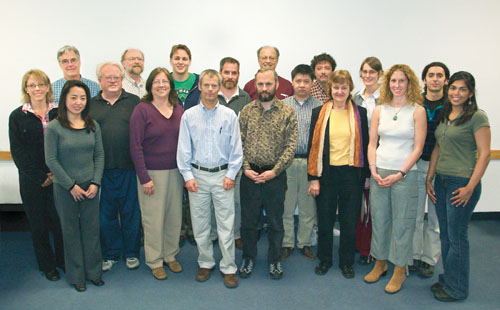 Left to right are: Robin Johnston, Shanshan Taylor, Jim Miller, Jim
Galvin, Gerald Przybylski, Kathy Bjornstad, Chris Rosen, Bill Edwards,
Carl Haber, Spencer Klein, Ashok Gadgil, Yanbo Pang, Allan Chen, Lara
Gundel, Christie Galitsky, Pam Seidenman, Azriel Goldschmidt, and
Heena Patel.
Left to right are: Robin Johnston, Shanshan Taylor, Jim Miller, Jim
Galvin, Gerald Przybylski, Kathy Bjornstad, Chris Rosen, Bill Edwards,
Carl Haber, Spencer Klein, Ashok Gadgil, Yanbo Pang, Allan Chen, Lara
Gundel, Christie Galitsky, Pam Seidenman, Azriel Goldschmidt, and
Heena Patel.
For the third consecutive year, the Technology Transfer Department held a ceremony to recognize all R&D 100 entries from Berkeley Lab and the people who contributed to the effort — everyone from the researchers whose technologies were nominated to the writers and editors who made the nominations possible. Berkeley Lab entered five projects from five different divisions — Life Sciences, AFRD, Environmental Energy Technologies, Engineering, Physical Biosciences, and Computing Sciences. The projects entered are:
- Berkeley Lab Optical Sound Restoration System
- Neural Matrix CCD
- Ion Mobility Analysis for Rapid Identification of Cardiovascular Disease Indicators
- Arsenic Removal Using Bottom Ash
- High-speed Autonomous Remote Data Acquisition System
The ceremony was held on April 26.
Berkeley Lab View
Published every two weeks by the Communications Department for the employees and retirees of Berkeley Lab.
Reid Edwards, Public Affairs Department head
Ron Kolb, Communications Department head
EDITOR
Monica Friedlander, 495-2248, msfriedlander@lbl.gov
STAFF WRITERS
Lyn Hunter, 486-4698
Dan Krotz, 486-4019
Paul Preuss, 486-6249
Lynn Yarris, 486-5375
CONTRIBUTING WRITERS
Jon Bashor, 486-5849
Allan Chen, 486-4210
David Gilbert, 925-296-5643
FLEA MARKET
486-5771, fleamarket@lbl.gov
Design
Caitlin Youngquist, 486-4020
Creative Services Office
Communications Department
MS 65, One Cyclotron Road, Berkeley CA 94720
(510) 486-5771
Fax: (510) 486-6641
Berkeley Lab is managed by the University of California for the U.S. Department of Energy.
Online Version
The full text and photographs of each edition of The View, as well as the Currents archive going back to 1994, are published online on the Berkeley Lab website under “Publications” in the A-Z Index. The site allows users to do searches of past articles.
Flea Market
- AUTOS & SUPPLIES
- ‘02 TOYOTA SIENNA LE, auto, air, am/fm/CD, pwr locks/win, 29K mi, runs great, $18,000/bo, Adele, X5803, (925) 788-2877
- ‘00 FORD ESCORT, forest green, 47K mi, 4 cyl, 5 sp manual, 110 hp, airbags, CD changer, exc cond, $5,000, Karl, X4793, 326-4938
- ‘96 TOYOTA CAMRY, 5 spd, am/fm, 109K mi, runs great, $4,000/bo, Adele, X5803, (925) 788-2877
- MOTORCYCLES
- ‘94 YAMAHA YZF750, 23K mi, orig owner, a beauty, see http://india. cchem.berkeley.edu/~reimer/bike.jpg, $2,500, 642-8011
- ‘87 YAMAHA MOTOR SCOOTER, reliable, $200/bo, Adele, X5803, (925) 788-2877
- HOUSING
- BERKELEY, resid community of scientists/staff/grad students, Hearst Commons, 1146-1160 Hearst nr UC/pub trans/BART, res parking, internet, studio townhouses w/ decks, furn can be provided at no cost, hardwd flrs, skylights, dw, ac, intercom, sec, units from $850, 848-5371, http://www.live-work.us/cgi-bin/artbooks/berkeley.html
- BERKELEY, Cedar/MLK, fully furn 2 bdrm+study/1 bth house, spacious w/ jacuzzi, garden, walk to campus, lab shuttle, shops, BART, http://www.bullybear.org/lp/pic.html, avail mid June, $1,900/mo+util, dep, no smok/pets, 1-yr lease, Lan-Ping, lpysjw@hotmail.com , 665-3166
- BERKELEY HILLS, fully furn rm w/ sep entry, full kitchen privil, w&d, quiet neighborhood, lovely backyard, next to bus stop, avail now, labartists@aol.com, 524-3851
- BERKELEY HILLS, bay view, lge sunny furn room, 17’x15’, priv ent, own bthrm, quiet neighborhood near UC/pub trans/shops, cooking facil in adj rm, pool table, workout mach, w&d, $875/mo incl linens, dishes, utils, phone line, wireless DSL, dish satellite TV/VCR, no smok/pets, short stays $325/wk, Carol, 524-6692
- BERKELEY HILLS, by wk/mo, quiet furn suite, 1 bdrm/1 bth/livng rm/ kitchenette, quiet, eleg & spacious, bay views, DSL, cable, walk to UCB, Pierre, 387-4015, pchew@pacbell.net
- EL CERRITO, 3+ bdrm furn home avail 7/01 for 1 yr, near schools, BART, shopping, view, borders Hillside Nature Area, photo at http://india.cchem.berkeley.edu/ ~reimer/house.jpg, $2,000/mo + dep, reimer@berkeley.edu
- NORTH BERKELEY, by week/mo, fully furn, 1/1 flat, quiet, spacious & comfortable, dish TV, laundry rm, priv garden, gated carport, walk to shuttle/UCB/pub trans, BART, downtown Berkeley, 848-1830, gfchew@mindspring.com
- HOUSING WANTED
- 2 BDRM OR LARGE 1 BDRM, sunny, w/ yard/deck, close to UCB/LBNL, unfurn, starting 6/1, Lothar, X4555
- MISC ITEMS FOR SALE
- MICROWAVE, Whirlpool, white, 1.2 cu-ft, exc cond, $25, Ron, X4410, 276-8079
- OAK HARVEST TABLE, hand-crafted, Borkholder, 36”x60”, $250; Stuart’s Oak 4-drawer cabinet, 56”x19.5” x25”, $250; oak chair on casters, $50, Mike, X5224, 482-1700
- QUEEN MATTRESS, include box & bedframe, 4 wheels, 1.5 years, exc cond, $200, Karl, X4793, 326-4938
- QUEEN SIZE MATTRESS, box & metal frame, good cond, $45; night stand table, $6; bike hat, $6; game table w/ games, $20, Lou or Jenny (925) 296-5760, 841-2140
- LOST
- WEDDING BAND, $50 reward, lost on 4/7, (707) 373-3025
- VACATION
- KIHEI, MAUI, 1 bdrm condo across street from best beach on Maui, Kamaole II, fully equipped, ocean & garden view from lanai, 4 night min, $90/night/$525/wk, Faye/John, X6787, X7505, 724-2982, 524-8734 eves
- SO LAKE TAHOE, spacious chalet in Tyrol area, close to Heavenly, fully furn, sleeps 8, sunny deck, pool & spa in club house, close to casinos & other attractions, $150/day +$100 one-time cleaning fee, Angela, X7712, or Pat/Maria, 724-9450
- TAHOE KEYS, HOUSE, 3 bdrm/2.5 bth, fenced yard, quiet sunny location, skiing nearby, great views of water & mountains, $195/night, 2 night min, Bob (925) 376-2211
Flea Market Policy
Ads are accepted only from Berkeley Lab employees, retirees, and onsite DOE personnel. Only items of your own personal property may be offered for sale.
Submissions must include name, affiliation, extension, and home phone. Ads must be submitted in writing
(e-mail: fleamarket@lbl.gov, fax: X6641), or mailed/ delivered to Bldg. 65. Email address are included only in housing ads.
Ads run one issue only unless resubmitted, and are repeated only as space permits. The submission deadline for the May 13 issue is Thursday, May 6.